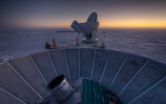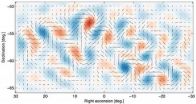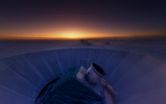(Press-News.org) Researchers with the National Science Foundation-funded BICEP2 Collaboration today announced that their telescope in Antarctica has allowed them to collect what they believe is the first direct evidence for cosmic inflation.
Inflation is the cataclysmic event in which, in a fleeting fraction of a second following the Big Bang, the infant universe expanded exponentially, stretching far beyond the view of the best telescopes.
Modern astronomy is built around the theory that almost 14 billion years ago, the universe burst into existence in an extraordinary event that initiated the Big Bang, which was then followed by the superluminal inflation of spacetime that created the current universe as we know it.
But until the BICEP results were announced, all of the scientific conjecture on inflation was built solely on a solid theoretical framework. Now, using data gathered by an NSF-funded telescope located at the geographic South Pole, the collaboration has described what it says are the first direct, observational evidence of inflation.
The findings, the collaboration's researchers believe, also represent the first images of gravitational waves or ripples in spacetime, and confirm a deep connection between quantum mechanics and general relativity. These waves have been described as the "first tremors of the Big Bang."
"Detecting this signal is one of the most important goals in cosmology today. A lot of work by a lot of people has led up to this point," said John Kovac, of the Harvard-Smithsonian Center for Astrophysics, the leader of the BICEP2 collaboration, which is funded by the Division of Polar Programs in NSF's Geosciences Directorate and NSF's Division of Astronomical Sciences.
Through the Division of Polar Programs, NSF manages the U.S. Antarctic Program, which coordinates all U.S. research on the southernmost continent and the complex logistics required to support the science.
The results were announced at a press conference at 11:55 a.m. today.
A technical presentation preceded the press conference.
BICEP2 is the second stage of the NSF-funded collaborative program. Harvard University and the Keck Foundation also contributed funding for the construction of the team's telescopes at Amundsen-Scott South Pole Station, which is one of three year-round U.S. Antarctic Program research stations.
In addition to Kovac, the NSF-funded principal investigators for the BICEP2 project are Clem Pryke of the University of Minnesota; Jamie Bock of the California Institute of Technology's Jet Propulsion Laboratory; and Chao-Lin Kuo of the Stanford Linear Accelerator Center.
Other major collaborating institutions for BICEP2 include the University of California, San Diego; the University of British Columbia; the National Institute of Standards and Technology; the University of Toronto; Cardiff University; and France's Commissariat à l'Energie Atomique.
In addition to NSF support for BICEP, NASA's Jet Propulsion Laboratory and the Moore Foundation supported the development of the ultra-sensitive detector arrays, which made the measurements possible.
The team examined spatial scales on the sky spanning about one to five degrees (two to ten times the width of the full Moon). To do this, they traveled to the South Pole Station to take advantage of the cold, dry, stable air over Antarctica's Polar Plateau, which rises thousands of meters above sea level.
"The South Pole is the closest you can get to space and still be on the ground," said Kovac. "It's one of the driest and clearest locations on Earth, perfect for observing the faint microwaves from the Big Bang."
The groundbreaking results came from observations by the BICEP2 telescope of the cosmic microwave background -- a faint glow left over from the Big Bang. Tiny fluctuations in this afterglow provide clues to conditions in the early universe.
For example, small differences in temperature across the sky show where parts of the universe were denser, eventually condensing into galaxies and galactic clusters.
Since the cosmic microwave background is a form of light, it exhibits all the properties of light, including polarization. On Earth, sunlight is scattered by the atmosphere and becomes polarized, which is why polarized sunglasses help reduce glare. In space, the cosmic microwave background was scattered by atoms and electrons and became polarized too.
"Our team hunted for a special type of polarization called 'B-modes,' which represents a twisting or 'curl' pattern in the polarized orientations of the ancient light," said Bock.
Gravitational waves squeeze space as they travel, and this squeezing produces a distinct pattern in the cosmic microwave background. Gravitational waves have a 'handedness,' much like light waves, and can have left- and right-handed polarizations.
"The swirly B-mode pattern is a unique signature of gravitational waves because of their handedness. This is the first direct image of gravitational waves across the primordial sky," said Kuo.
The researchers were surprised to detect a B-mode polarization signal considerably stronger than many cosmologists expected. The team analyzed their data for more than three years in an effort to rule out any errors. They also considered whether dust in our galaxy could produce the observed pattern, but the data suggest this is highly unlikely. "This has been like looking for a needle in a haystack, but instead we found a crowbar," said Pryke.
Vladimir Papitashvili, the U.S. Antarctic Program's astrophysics and geospace sciences program director, said "the South Pole is an excellent place for Cosmic Microwave Background observations during the long, dark, and very cold winter. It reflects well on the NSF/USAP-supported BICEP team that they are now able to bring forward, for the first time, this long-awaited B-mode polarization signal so that their work can be examined by the broader astrophysics community."
Asked to comment on the implications of this discovery, Harvard theorist Avi Loeb said, "this work offers new insights into some of our most basic questions: Why do we exist? How did the universe begin? These results are not only a smoking gun for inflation, they also tell us when inflation took place and how powerful the process was."
INFORMATION:
Technical details and journal papers can be found on the BICEP2 release website. The BICEP2 results will be submitted to a peer-reviewed journal for publication.
NSF-funded researchers say Antarctic telescope may have provided the first direct evidence of cosmic
Uniquely cold and dry conditions of the atmosphere over Antarctica's polar plateau made the observations possible
2014-03-18
ELSE PRESS RELEASES FROM THIS DATE:
A novel mechanism for fast regulation of gene expression
2014-03-18
VIDEO:
Ben-Shahar describes research with fruit flies that shows messenger RNA plays an active as well as a passive role in the cell. In addition to encoding for a protein, it...
Click here for more information.
Our genome, we are taught, operates by sending instructions for the manufacture of proteins from DNA in the nucleus of the cell to the protein-synthesizing machinery in the cytoplasm. These instructions are conveyed by a type of molecule called messenger RNA (mRNA).
Francis ...
New lens design drastically improves kidney stone treatment
2014-03-18
DURHAM, N.C. -- Duke engineers have devised a way to improve the efficiency of lithotripsy -- the demolition of kidney stones using focused shock waves. After decades of research, all it took was cutting a groove near the perimeter of the shock wave-focusing lens and changing its curvature.
"I've spent more than 20 years investigating the physics and engineering aspects of shock wave lithotripsy," said Pei Zhong, the Anderson-Rupp Professor of Mechanical Engineering and Materials Science at Duke University. "And now, thanks to the willingness of Siemens (a leading lithotripter ...
Sea anemone is genetically half animal, half plant
2014-03-18
The team led by evolutionary and developmental biologist Ulrich Technau at the University of Vienna discovered that sea anemones display a genomic landscape with a complexity of regulatory elements similar to that of fruit flies or other animal model systems. This suggests, that this principle of gene regulation is already 600 million years old and dates back to the common ancestor of human, fly and sea anemone. On the other hand, sea anemones are more similar to plants rather to vertebrates or insects in their regulation of gene expression by short regulatory RNAs called ...
Effect of receptor activity-modifying protein-1 on vascular smooth muscle cells
2014-03-18
Bei Shi, Xianping Long, Ranzun Zhao, Zhijiang Liu, Dongmei Wang and Guanxue Xu, researchers at the First Affiliated Hospital of Zunyi Medical College within the Guizhou Province of China, have reported an approach for improving the use of stem cells for improvement of infarcted heart function and damage to the arteries in the March 2013 issue of Experimental Biology and Medicine. They have discovered that mesenchymal stem cells (MSCs) transfected with a recombinant adenovirus containing the human receptor activity-modifying protein 1 (hRAMP1) gene (EGFP-hRAMP1-MSCs) when ...
Vast gene-expression map yields neurological and environmental stress insights
2014-03-18
A consortium led by scientists from the U.S. Department of Energy's Lawrence Berkeley National Laboratory (Berkeley Lab) has conducted the largest survey yet of how information encoded in an animal genome is processed in different organs, stages of development, and environmental conditions. Their findings paint a new picture of how genes function in the nervous system and in response to environmental stress.
They report their research this week in the Advance Online Publication of the journal Nature.
The scientists studied the fruit fly, an important model organism ...
Chinese scientists report new findings on mutations identification of esophageal cancer
2014-03-18
March 16, 2014, Shenzhen, China – In a collaborative study, researchers from Chinese Academy of Medical Sciences and Peking Union Medical College, BGI, Shantou University Medical College and other institutions identified important alterations of tumor-associated genes and tumorigenic pathways in esophageal squamous cell cancer (ESCC), one of the leading cause of cancer death worldwide. The all-round work was published online today in the international journal Nature, providing a new eye-opening insight into developing novel biomarkers for therapeutic strategies of this ...
How diabetes drugs may work against cancer
2014-03-18
CAMBRIDGE, Mass. (March 16, 2014) – For several years, a class of anti-diabetic drugs known as biguanides, has been associated with anti-cancer properties. A number of retrospective studies have shown that the widely used diabetes drug metformin can benefit some cancer patients. Despite this intriguing correlation, it has been unclear how metformin might exert its anti-cancer effects and, perhaps more importantly, in which patients.
Now, Whitehead Institute scientists are beginning to unravel this mystery, identifying a major mitochondrial pathway that imbues cancer ...
Less is more: New theory on why very low nutrient diets can extend lifespan
2014-03-18
UNSW scientists have developed a new evolutionary theory on why consuming a diet that is very low in nutrients extends lifespan in laboratory animals - research that could hold clues to promoting healthier ageing in humans.
Scientists have known for decades that severely restricted food intake reduces the incidence of diseases of old age, such as cancer, and increases lifespan.
"This effect has been demonstrated in laboratories around the world, in species ranging from yeast to flies to mice. There is also some evidence that it occurs in primates," says lead author, Dr ...
Electronic media associated with poorer well-being in children
2014-03-18
Bottom Line: The use of electronic media, such as watching television, using computers and playing electronic games, was associated with poorer well-being in children.
Author: Trina Hinkley, Ph.D., of Deakin University, Melbourne, Australia, and colleagues.
Background: Using electronic media can be a sedentary behavior and sedentary behavior is associated with adverse health outcomes and may be detrimental at a very young age.
How the Study Was Conducted: The authors used data from the European Identification and Prevention of Dietary- and Lifestyle-Induced Health ...
COPD associated with increased risk for mild cognitive impairment
2014-03-18
Bottom Line: A diagnosis of chronic obstructive pulmonary disease (COPD) in older adults was associated with increased risk for mild cognitive impairment (MCI), especially MCI of skills other than memory, and the greatest risk was among patients who had COPD for more than five years.
Author: Balwinder Singh, M.D., M.S., of the Mayo Clinic, Rochester, Minn., and colleagues.
Background: COPD is an irreversible limitation of airflow into the lungs, usually caused by smoking. More than 13.5 million adults 25 years or older in the U.S. have COPD. Previous research has suggested ...
LAST 30 PRESS RELEASES:
Making lighter work of calculating fluid and heat flow
Normalizing blood sugar can halve heart attack risk
Lowering blood sugar cuts heart attack risk in people with prediabetes
Study links genetic variants to risk of blinding eye disease in premature infants
Non-opioid ‘pain sponge’ therapy halts cartilage degeneration and relieves chronic pain
AI can pick up cultural values by mimicking how kids learn
China’s ecological redlines offer fast track to 30 x 30 global conservation goal
Invisible indoor threats: emerging household contaminants and their growing risks to human health
Adding antibody treatment to chemo boosts outcomes for children with rare cancer
Germline pathogenic variants among women without a history of breast cancer
Tanning beds triple melanoma risk, potentially causing broad DNA damage
Unique bond identified as key to viral infection speed
Indoor tanning makes youthful skin much older on a genetic level
Mouse model sheds new light on the causes and potential solutions to human GI problems linked to muscular dystrophy
The Journal of Nuclear Medicine ahead-of-print tip sheet: December 12, 2025
Smarter tools for peering into the microscopic world
Applications open for funding to conduct research in the Kinsey Institute archives
Global measure underestimates the severity of food insecurity
Child survivors of critical illness are missing out on timely follow up care
Risk-based vs annual breast cancer screening / the WISDOM randomized clinical trial
University of Toronto launches Electric Vehicle Innovation Ontario to accelerate advanced EV technologies and build Canada’s innovation advantage
Early relapse predicts poor outcomes in aggressive blood cancer
American College of Lifestyle Medicine applauds two CMS models aligned with lifestyle medicine practice and reimbursement
Clinical trial finds cannabis use not a barrier to quitting nicotine vaping
Supplemental nutrition assistance program policies and food insecurity
Switching immune cells to “night mode” could limit damage after a heart attack, study suggests
URI-based Global RIghts Project report spotlights continued troubling trends in worldwide inhumane treatment
Neutrophils are less aggressive at night, explaining why nighttime heart attacks cause less damage than daytime events
Menopausal hormone therapy may not pose breast cancer risk for women with BRCA mutations
Mobile health tool may improve quality of life for adolescent and young adult breast cancer survivors
[Press-News.org] NSF-funded researchers say Antarctic telescope may have provided the first direct evidence of cosmicUniquely cold and dry conditions of the atmosphere over Antarctica's polar plateau made the observations possible





